
|
Back to |
| The Front Page |
| The Game |
|
The newly revised laws: How do they affect your game? |
||||||
|
By Martyn Selman, Photographs by Mike Orgill Posted April 12, 2008
|
||||||
|
||||||
The International Laws Committee were actively engaged in a yearlong process beginning in early 2007, writing new language for many of the specific laws and circulating them for comment and discussion by the croquet world. The final draft was proposed in late December and was soon formally approved by the major associations. The new edition took effect on March 15, 2008, in the United States and Great Britain and shortly thereafter in other countries.
Although most of the changes have little or no bearing on the substance of the game, much of the new language is crafted to make the laws easier to understand and less subject to multiple or opposing interpretations.
|
WHAT IS THE INTERNATIONAL |
|
The International Laws Committee is responsible for interpreting and changing the laws of croquet, approving the published versions, and making official rulings on questions about their meaning between publication. The Committee is composed of one representative from each of the countries with the biggest population of players of Association [International Rules] Croquet. Agreement from all four countries is required for a law to be changed. The Committee members are: Australia, Max Hooper; Great Britain, Ian Vincent; New Zealand, Graeme Roberts; and the United States, Martyn Selman.
|
How the revision was done
The process was begun at the 2007 MacRobertson Shield in Australia, with a meeting of the representatives to the International Laws Committee to set the initial scope of the revision. The committee members worked well together. Ideas were constantly circulated, with new ones adopted and old ones discarded. The spirit was one of cooperation, and there were no hard feelings over disagreements.
Nine official drafts were created. Four drafts were published on the Nottingham Board for comment - of which there was much. The ILC found much of the public discussion extremely helpful.
Some of the changes were very technical and will be noticed by no one but the pedants. This does not mean that making those changes in language was a waste of time, as those laws are now less subject to misinterpretation. (If you followed the Nottingham Laws discussion - as tedious as it may have seemed at time - you will also know that the pedants care passionately about all aspects of the laws.)
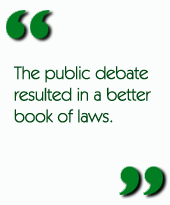
Public contributions led to new ideas and better execution of the ideas - in some cases picking up inaccuracies or ambiguities in proposed language. All in all, the public debate resulted in a better book of laws.
The only thing that did not work well was the informal voting that the committee requested of the croquet-playing public where more than one reasonable option presented itself. Unfortunately, some of the public votes were also split, providing the committee limited guidance.
The changes in interpretive language are not discussed here. But several of the amendments actually change particular aspects of how the game is played, and you need to know what they are and how the work.
Interference with a Ball
Law #33
Law 33 is entitled "Interference with a Ball." It covers interference by the players (although if the striker interferes with a ball, that can also be a fault). The interference could also be the weather or other "outside agency." The outside agency is usually a double banking ball, but could just as easily be a dog running onto the court and absconding with one of the balls in play. (Thanks to Lewis Carroll, the hedgehog is a favorite metaphor for describing an outside agent.)
The basic rules relating to a stationary ball remain the same - it is replaced to where it was before the interference. Principles relating to the weather have also not changed: if the wind moves a stationary ball, replace it (and hard luck if you were about to roquet it in the new position); and a player is not entitled to claim interference if the wind blows a moving ball off-course.
The old law on interference with a moving ball was not well understood and was poorly applied by many players. The committee hopes the new law will make the game flow better by requiring fewer replays when balls from different games collide during double banking.
Most players in the US wrongly believed (under the old law) that they should replay the stroke if they could not accurately predict where the ball would have gone had it not suffered interference. In fact, the law said nothing of the sort. Also, many players have fallen into the habit of not marking double banking balls that may be in the way, so there have been frequent unnecessary collisions of balls in different games on the same court.
The new law sets out in unmistakable terms all the circumstances in which a replay is permitted. It is hoped that more players will now understand the law, and that there will be fewer interruptions because of replays.
Under the new Law 33, players must replay a stroke when (1) the outside agent (usually a double banked ball) moved after the striker took up his stance, and (2) a point may have been scored, a roquet made, or the ball that suffered interference may have stopped in a critical position.
 If the circumstances meet these conditions, a replay is mandatory. But in no other case is a replay permitted - even if the players cannot agree on where the ball would have stopped.
If the circumstances meet these conditions, a replay is mandatory. But in no other case is a replay permitted - even if the players cannot agree on where the ball would have stopped.
What happens if players do not agree about where the balls would have stopped? Previously in the US, this was often the trigger for a replay. Now, the players must come to a decision about where to place the balls.
Under an amended Law 48, the opinion of the adversary is to be preferred in such circumstances. This does not mean that the adversary must have been watching. For example, the striker takes off from near the second hoop and hits a double banked ball near the peg. If the striker claims the ball would have stopped two feet from the red ball near corner 2, with a perfect rush to the peg, the adversary is perfectly entitled to have a contrary opinion, even if he has not seen the shot.
To avoid disruptions to the game and disagreements with the opponent, it's now more important than ever to mark all double banking balls that might get in the way.
Replay after playing to misplaced balls
Law #31
Under the old law, it was bad luck if the striker played to or aimed at balls that had been moved by someone else and not replaced. For example, a double banker moves balls and does not tell the striker, the striker takes off to the balls in the misplaced positions, then someone realises that the balls are in the wrong place. The misplaced balls were placed in the proper place, but the striker still had to play from where his striker's ball stopped. Some pundits strongly felt that the striker should always keep track of where the balls are, and it is the striker's bad luck if someone moves the balls and the striker does not notice. However, it seems that many players did not hold themselves to this level of perfection, and the majority agreed that a player should not be responsible for double bankers' carelessness.
Accordingly, it was decided that a player may claim that he was misled and claim a replay under Law #31 a 2 if he plays to or at balls that have been moved by someone else.
Faults
Law #28 a 1; Law #28 a 15; Law 48 d 4
The main changes in the laws on faults are set out below.
Some players have adopted the practice of sliding their mallet along their foot to keep it on course - particularly when they are playing a hampered stroke. They have found this a useful way to keep the mallet on line when the backswing is hampered by a nearby hoop. Other players have maintained that this does not help. The committee felt that the swing should always be free and unguided, and Law #28 a 1 has been amended to state that it is now a fault to guide the mallet by sliding it along your foot. (However, the laws still permit players to slide the mallet along the upright of the hoop.)
When should a fault be called for lawn damage under Law #28 a 15? The law was occasioned by an Australian player, Peter Olson, who employed an a cte hammer stroke near a hoop. Because he buried the mallet in the lawn, there was no follow through and no risk of a crush. Since then, some referees have begun to call a fault for any break in the lawn surface, while others didn't care unless the player dug a small ditch. Law #28 a 15 has been clarified to allow a fault for lawn damage only if:
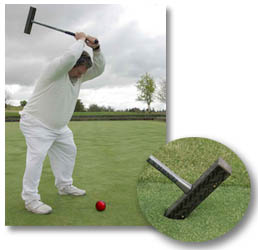
|
| Robert Coleman demonstrates the ax hammer stroke - with gusto... and is faulted under all rules. |
- the striker's swing is hampered,
- the strike is attempting a jump shot or
- the striker is playing a cannon
Finally, there has been no clear standard for judging a fault - until now. Previously, some players and referees called a fault only if they were absolutely certain one had occurred (i.e. almost never), while some called a fault at the first hint of a problem. A clear standard has been in troduced in Law 48 d 4. That standard is the balance of probabilities - which means that fault should be declared when the striker or referee believes it was more likely than not that a fault was committed.
Cannons
Law #6 h
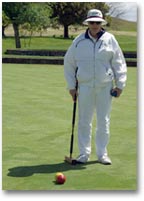
|
| Blue rushes red, which stops in contact with yellow. Mike Orgill of the Sonoma-Cutrer Croquet Club contemplates his options. |
Although it happens only rarely, balls do sometimes stop in contact in the middle of the lawn. For example, blue rushes yellow, and yellow comes to rest in contact with red near the peg. Under the previous laws, blue could be placed in any position in contact with yellow, and not in contact with red, but red and yellow could not legally be moved. Players who found themselves in this position were unable to play y ellow to anywhere useful and had to be very careful to get good position on red. The situation was worse when blue was dead on red, and players could lose their break.
Although it happens only rarely, three balls do sometimes stop in contact in the middle of the lawn. For example, red rushes yellow, and yellow comes to rest in contact with black near the peg. Under the previous laws, red could be placed in any position in contact with yellow, and not in contact with black, but black and yellow could not be moved. Players who found themselves in this position were often in trouble and could lose their break as a result.
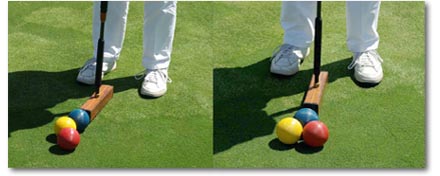
|
| New laws allow Mr Orgill to form a cannon on the court and move yellow. He now has a reasonable chance of rushing to his current hoop while sending a pioneer to the next hoop and continuing his break. |
Under the new law, black and red are now both balls-in-hand. Both balls can be placed in any position touching yellow, giving the striker a new set of options.
Ball Jamming in a Hoop
Law #53 b 3
Players have long been permitted a replay if the ball jammed in a hoop. However, it was tough luck if the ball bounced out of the hoop on the replay, leaving the striker in a worse position than jammed in the hoop. Many thought this unfair, as it was up to luck whether the ball stayed in the hoop or not. Now, under Law #53 b 3, if advertised in advance for a tournament, a player will be permitted a replay if the outcome of a stroke was affected because the ball is bigger than the hoop - regardless of whether the ball remained jammed in the jaws and regardless of whether the ball ran the hoop or not. (In the US, this rule will apply in all Association Laws tournaments.)
Playing when not entitled
Law #25
Law 25 has been redrafted to rid it of several undesirable consequences.
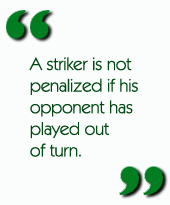
Under the old law, the player was required to put all the balls back to where they were when the opponent played out of turn - unfair if the striker had made a long roquet or a difficult hoop. Indeed, the report of a lady in Australia was what brought the problem to the committee's at tention. The lady reportedly stood aside to wait for a double banker. Her opponent was not watching properly and played a stroke at the other end of the lawn. Resuming play, the correct striker hit a 14-yard roquet, then looked around and realized what her opponent had done. She was required to put all balls back and attempt the roquet again. She felt understandably aggrieved to be punished for her opponent's error.
The new law 25 states that when a player plays out of turn, any balls moved by the offending side are replaced and any points scored by the offending side are canceled. There is no longer the need to replace all balls and cancel all points. This means that a striker is not penalized if his opponent has played out of turn.
Bisques after Fault
Law # 37 h
When a fault occurred in a handicap game, the old law put the players through a process more complicated than the peacock mating dance. The new Law 37 h has taken much of the angst out of the situation, which is now not very different from ordinary play. After a fault, the adversary first decides whether to replace the balls or leave them where they lie. The striker then decides whether to take a bisque.
Each revised edition of the Laws of Association Croquet occasions new opportunities for further improvement in the next revision, based on the actual experiences that players report to the Laws Committee. Croquet is a game of almost infinite tactical possibility and, inevitably, players all over the world will discover new and unusual applications of the revised laws, and new questions will emerge. You are invited to send those questions and comments to the Laws Committee.